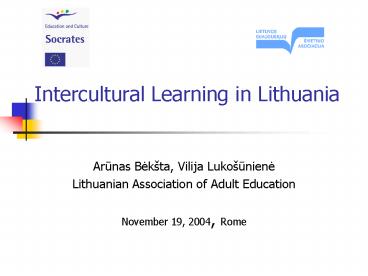Intercultural Learning in Lithuania - PowerPoint PPT Presentation
1 / 12
Title:
Intercultural Learning in Lithuania
Description:
Our focus- minority groups. Few trainings for minority groups found - most activities cultural ... Folk art, dances, songs, national dresses, national cuisine ... – PowerPoint PPT presentation
Number of Views:25
Avg rating:3.0/5.0
Title: Intercultural Learning in Lithuania
1
Intercultural Learning in Lithuania
- Arunas Bekta, Vilija Lukouniene
- Lithuanian Association of Adult Education
- November 19, 2004, Rome
2
Foreigners in Lithuania (2003)
- 27 900 foreigners permanently resident
- 12 400 Russians
- 2000 Byelorussians
- 1400 Ukrainians
- Rest- persons without citizenship
3
Seeking refugee status
- Chechens 42
- Punjabi 20
- Pushtoons 8
- Russians 7
- Palestinian Arabs 5
- Others 18
4
Ethnical composition (2001)
5
Situation in Lithuania
- Low immigration. Major concern of the State -
social security - University programs
- Several projects
- Our focus- minority groups
- Few trainings for minority groups found - most
activities cultural festivals - Education of ethnic minorities
- Secondary schools (Polish, Byelorussian, Russian,
Jewish) - Sunday schools (for learning mother languages)
6
Intercultural Competence for Europe Socrates
Grundtvig programme
- Cultural communication between local people and
migrants - Cultural communication between national
minorities and the majority - Participants of different nationalities, social
background, age and gender
7
Culture - iceberg
Folk art, dances, songs, national dresses,
national cuisine
10
Beauty, justice, time, emotions, madness, sin,
death.
?
90
8
Being together
- What should we do in order to understand each
other, to listen to each other and to hear each
other?
9
Being together
- Understanding behavior
- Understanding the feeling of the world
- Basing communication on similarities
10
Instruments
- Theoretical knowledge (not enough)
- Practical skills
- Personal knowing of people
- Knowing of cultures
- Communication solving common problems
- Informal environment
11
Some conclusions
- Learning of cultural understanding demands time,
patience, efforts and creativity, no hurry, no
moralization - Learning by BEING TOGETHER- observing, talking,
listening, explaining - Flexibility in methods, place and time
- Everything you see, hear and do can tell the
story and provides opportunity to learn
12
Nothing works the way to peoples togetherness
so well as knowing each other Gabriele
Petkevicaite- Bite































